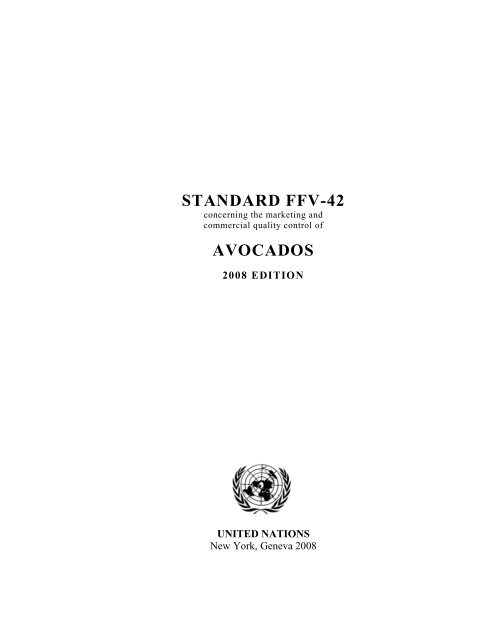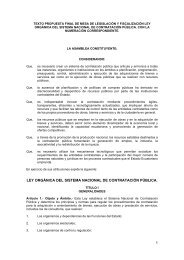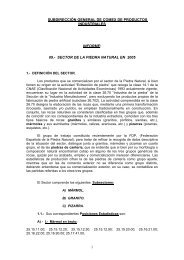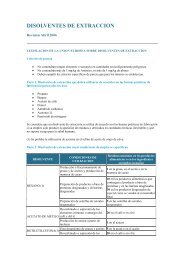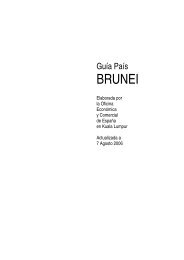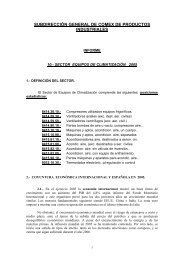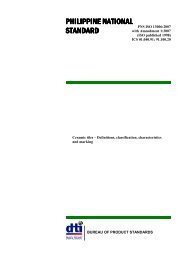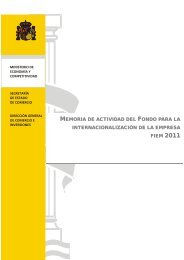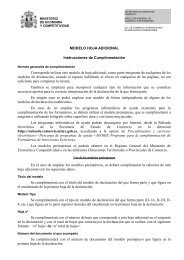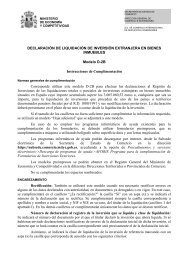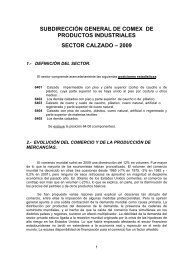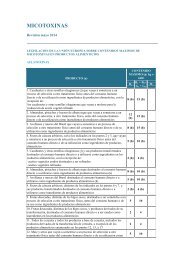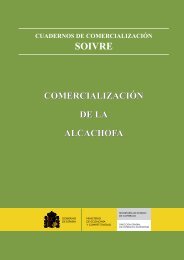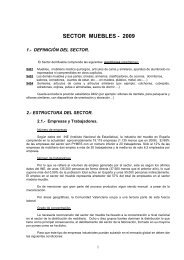STANDARD FFV-42 AVOCADOS
STANDARD FFV-42 AVOCADOS
STANDARD FFV-42 AVOCADOS
- No tags were found...
Create successful ePaper yourself
Turn your PDF publications into a flip-book with our unique Google optimized e-Paper software.
<strong>STANDARD</strong> <strong>FFV</strong>-<strong>42</strong>concerning the marketing andcommercial quality control of<strong>AVOCADOS</strong>2008 EDITIONUNITED NATIONSNew York, Geneva 2008
<strong>FFV</strong>-<strong>42</strong>: AvocadosPage 2NOTEWorking Party on Agricultural Quality StandardsThe commercial quality standards developed by the UNECE Working Party onAgricultural Quality Standards help facilitate international trade, encourage high-qualityproduction, improve profitability and protect consumer interests. United Nations standardsare used by Governments, producers, traders, importers and exporters, and otherinternational organizations. They cover a wide range of agricultural products, includingfresh fruit and vegetables, dry and dried produce, seed potatoes, meat, cut flowers, eggsand egg products.Any member of the United Nations can participate, on an equal footing, in the activities ofthe Working Party. For more information on agricultural standards, please visit our website.The present revised Standard for Avocados is based on documentECE/TRADE/C/WP.7/2008/8, adopted by the Working Party at its sixty-fourth session.The designations employed and the presentation of the material in this publication do notimply the expression of any opinion whatsoever on the part of the United NationsSecretariat concerning the legal status of any country, territory, city or area or of itsauthorities, or concerning the delimitation of its frontiers or boundaries. Mention ofcompany names or commercial products does not imply endorsement by the UnitedNations.All material may be freely quoted or reprinted, but acknowledgement is requested.Please contact the following address with any comments or enquiries:Agricultural Standards UnitTrade and Timber DivisionUnited Nations Economic Commission for EuropePalais des NationsGeneva 10, CH-1211, SwitzerlandTel: +41 22 917 1366Fax: +41 22 917 0629e-mail: agristandards@unece.org
<strong>FFV</strong>-<strong>42</strong>: AvocadosPage 3I. DEFINITION OF PRODUCE<strong>STANDARD</strong> <strong>FFV</strong>-<strong>42</strong>concerning the marketing andcommercial quality control of<strong>AVOCADOS</strong>This standard applies to avocados of varieties (cultivars) grown from Persea americana Mill. tobe supplied fresh to the consumer, parthenocarpic fruit and avocados for industrial processingbeing excluded.II.PROVISIONS CONCERNING QUALITYThe purpose of the standard is to define the quality requirements of avocados at the exportcontrolstage, after preparation and packaging.However, if applied at stages following export, products may show in relation to therequirements of the standard:- a slight lack of freshness and turgidity- for products graded in classes other than the “Extra” Class, a slight deterioration due totheir development and their tendency to perish.The holder/seller of products may not display such products or offer them for sale, or deliver ormarket them in any manner other than in conformity with this standard. The holder shall beresponsible for observing such conformity.A. Minimum requirementsIn all classes, subject to the special provisions for each class and the tolerances allowed, theavocados must be:- intact- sound; produce affected by rotting or deterioration such as to make it unfit forconsumption is excluded- clean, practically free of any visible foreign matter- practically free from pests- free from damage caused by pests affecting the flesh- free of damage caused by low temperature- having a stalk not more than 10 mm in length which must be cut off cleanly.However, its absence is not considered a defect on condition that the place of thestalk attachment is dry and intact- free of abnormal external moisture- free of any foreign smell and/or taste. 11The use of preserving agents or any other chemical substance liable to leave a foreign smell on the skin of the fruitis permitted where it is compatible with the regulations of the importing country.
<strong>FFV</strong>-<strong>42</strong>: AvocadosPage 4The development and condition of the avocados must be such as to enable them:- to withstand transportation and handling- to arrive in satisfactory condition at the place of destination.B. Maturity requirementsThe development of the avocados should have reached a physiological stage, which will ensure acontinuation of the ripening process to completion.The fruit should have a minimum dry matter content, to be measured by drying to constantweight:21 % for the variety Hass20 % for the varieties Fuerte, Pinkerton, Reed and Edranol19 % for the other varieties except for Antillian varieties 2 that may show a lower drymatter content.The ripe fruit should be free from bitterness.C. ClassificationAvocados are classified in three classes, as defined below:(i)"Extra" ClassAvocados in this class must be of superior quality. In shape and colouring they must becharacteristic of the variety and/or commercial type.They must be free from defects, with the exception of very slight superficial defects,provided these do not affect the general appearance of the produce, the quality, thekeeping quality and presentation in the package. If present, the stalk must be intact.(ii)Class IAvocados in this class must be of good quality. They must be characteristic of the varietyand/or commercial type.The following slight defects, however, may be allowed provided these do not affect thegeneral appearance of the produce, the quality, the keeping quality and presentation in thepackage:2 Reservation from the United States: Antillean varieties should not be included in the standard because they aresubstantially different.
<strong>FFV</strong>-<strong>42</strong>: AvocadosPage 5- a slight defect in shape- slight defects in colouring- slight skin defects (corkiness, healed lenticels) and sunburn, provided they are notprogressive; the maximum total area should not exceed 4 cm 2 .In no case may the defects affect the fruit flesh.The stalk, if present, may be slightly damaged.(iii)Class IIThis class includes avocados that do not qualify for inclusion in the higher classes butsatisfy the minimum requirements specified above.The following defects may be allowed, provided the avocados retain their essentialcharacteristics as regards the quality, the keeping quality and presentation:- defects in shape- defects in colouring- skin defects (corkiness, healed lenticels) and sunburn, provided they are notprogressive; the maximum total area should not exceed 6 cm 2 .In no case may the defects affect the fruit flesh.The stalk, if present, may be damaged.III.PROVISIONS CONCERNING SIZINGSize is determined by the weight of the fruit.Minimum weight for avocados is 123 g except for Hass where it is 80 g.The size scale is as follows:Size codeWeight scale (g)4 781 to 12206 576 to 7808 456 to 57610 364 to 46212 300 to 37114 258 to 31316 227 to 27418 203 to 24320 184 to 21722 165 to 19624 151 to 17526 144 to 157
<strong>FFV</strong>-<strong>42</strong>: AvocadosPage 628 134 to 14730 123 to 137S 380 to123 (Hass variety only)IV.PROVISIONS CONCERNING TOLERANCESTolerances in respect of quality and size shall be allowed in each lot for produce not satisfyingthe requirements for the class indicated.A. Quality tolerances(i)"Extra" ClassA total tolerance of 5 per cent, by number or weight, of avocados not satisfying therequirements of the class but meeting those of Class I is allowed. Within this tolerance,not more than 0.5 per cent in total may consist of produce satisfying the requirements ofclass II quality.(ii)Class IA total tolerance of 10 per cent, by number or weight, of avocados not satisfying therequirements of the class but meeting those of Class II is allowed. Within this tolerancenot more than 1 per cent in total may consist of produce neither satisfying therequirements of Class II quality nor the minimum requirements. Produce affected byrotting or any other deterioration rendering it unfit for consumption is excluded.(iii)Class IIA total tolerance of 10 per cent, by number or weight, of avocados satisfying neither therequirements of the class nor the minimum requirements is allowed. Produce affected byrotting or any other deterioration rendering it unfit for consumption is excluded.B. Size tolerancesFor all classes: a total tolerance of 10 per cent, by number or weight, of avocados conforming tothe size range immediately below and/or above that mentioned in the marking.3The difference between the smallest and largest fruit within a package should not be more than 25 g.
<strong>FFV</strong>-<strong>42</strong>: AvocadosPage 7V. PROVISIONS CONCERNING PRESENTATIONA. UniformityThe contents of each package must be uniform and contain only avocados of the same origin,variety, quality, colouring 4 and size.The visible part of the contents of the package must be representative of the entire contents.B. PackagingThe avocados must be packed in such a way as to protect the produce properly.The materials used inside the package must be clean and of a quality such as to avoid causingany external or internal damage to the produce. The use of materials, particularly of paper orstamps bearing trade specifications, is allowed, provided the printing or labelling has been donewith non-toxic ink or glue.Stickers individually affixed on the produce shall be such that, when removed, they neither leavevisible traces of glue nor lead to skin defects.Packages must be free of all foreign matter.VI.PROVISIONS CONCERNING MARKINGEach package 5 must bear the following particulars, in letters grouped on the same side, legiblyand indelibly marked, and visible from the outside:A. IdentificationPacker ) Name and physical address (e.g. street/city/region/postal code and,and/or ) if different from the country of origin, the country) orDispatcher/shipper ) a code mark officially recognized by the national authority. 6B. Nature of produce- "Avocados", if the contents are not visible from the outside- Name of the variety.4A change in the colour of the dark-skinned varieties is not considered as a defect, but the colouring of the fruit ineach package must be uniform at the point of dispatch.5According to the Geneva Protocol, footnote 2, "Package units of produce prepacked for direct sale to theconsumer shall not be subject to these marking provisions but shall conform to the national requirements. However,the markings referred to shall in any event be shown on the transport packaging containing such package units".6The national legislation of a number of countries requires the explicit declaration of the name and address.However, in the case where a code mark is used, the reference "packer and/or dispatcher (or equivalentabbreviations)" has to be indicated in close connection with the code mark, and the code mark should be precededby the ISO 3166 (alpha) country/area code of the recognizing country, if not the country of origin.
<strong>FFV</strong>-<strong>42</strong>: AvocadosPage 8C. Origin of produce- Country of origin and, optionally, district where grown, or national, regional orlocal place name.D. Commercial specifications- Class- Size expressed in minimum and maximum weight- Code number of the size scale and number of fruits when it is different from codenumber or, optionally, code number of the size scale and the net weight of thepackage.E. Official control mark (optional)Published 1986Last revised 2008The OECD Scheme for the Application of International Standards for Fruit and Vegetables haspublished an explanatory illustrated brochure on the application of this standard. The publicationmay be obtained from the OECD bookshop at: www.oecdbookshop.org.


